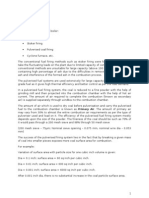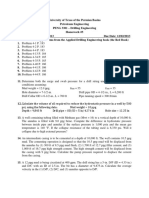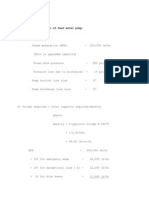Sample Computation For A Steam Pipe Line
Uploaded by
Au TagolimotSample Computation For A Steam Pipe Line
Uploaded by
Au TagolimotVerification of main steam line pipe size
The header to
subject a
steam
line
is
from
the
boiler
distribution
Mill.
This line is where the 250 psig steam
passes and goes to different turbine drives of the mill and auxiliaries.
Given: Steam @ 250 psig 506F 60 TPH flow through the pipe 100 m estimated length a) Compute for pipe size, D, using average velocity from Table 14-16 p. 603 Power Plant Engg by Morse), Flow area of pipe = mass flow (mf)/ density () x velocity (v) where: mf = 60 (2200) /60 = 2200 lb/min = 1 / specific vol. @ 265 psig & 505F = = v D / 4 1 / 2.0362 cu.ft/lb 0.4911 lb/cu.ft
= 3000 m/min or 9840 ft/min
= 2200 / 0.4911 x 9840
D b)
= 0.7613 ft, 9.136 in. say 10
Compute for pipe size using allowable pressure drop, P For the flow of steam or air (eq.14-11 p. 605 Power Plant
Engg by Morse) and P is 5 psi.
= f L d v / 5000 g D kg/cm where: f = coefficient of friction = 0.0054 L = 100 m d = 0.4911 (35.28) / 2.2 = 7.875 kg/m v = 2.694 m/sec /D g = 9.81 m/sec D = pipe diameter in m P = 0.3516 kg/cm 0.0054 (100)(7.875) [2.694)/D]
0.3516
= 5000 (9.81) (D)
D v
= 0.285 m or nearest is 12 diameter = 2.694 / (0.3048) = 29 m/sec
recomputed P recomputed P
= 4 psi (using 12 pipe) = 8 psi (using 10 pipe)
Choose 12 diameter pipe as taken from pressure drop method rather than 10 as obtained from velocity method to reduce
pressure drop.
You might also like
- 1996 - Misplon - Pinhole Grate Conversions ofNo ratings yet1996 - Misplon - Pinhole Grate Conversions of4 pages
- By K.K.PARTHIBAN, Boiler Consultant Venus Energy Audit SystemNo ratings yetBy K.K.PARTHIBAN, Boiler Consultant Venus Energy Audit System13 pages
- ESP For Bagasse Fired Steam Generators Seminar100% (2)ESP For Bagasse Fired Steam Generators Seminar14 pages
- Deaerator Working Principle: What Is Deaeration?No ratings yetDeaerator Working Principle: What Is Deaeration?4 pages
- Verification of Capacity of Secondary Air Fan For Bagasse Fired BoilerNo ratings yetVerification of Capacity of Secondary Air Fan For Bagasse Fired Boiler2 pages
- Types and Working Principles Steam Turbines100% (4)Types and Working Principles Steam Turbines69 pages
- Designing A Steam Jet Ejector and Its Measuring Equipment: Abstract - in This Paper I Discussed The Application andNo ratings yetDesigning A Steam Jet Ejector and Its Measuring Equipment: Abstract - in This Paper I Discussed The Application and7 pages
- Material Handling Systehls For THE Fluidized-Bed Combustion Boiler Rivesville, J. Rranam Rosborough The MITRE CcrporationNo ratings yetMaterial Handling Systehls For THE Fluidized-Bed Combustion Boiler Rivesville, J. Rranam Rosborough The MITRE Ccrporation20 pages
- Centrifugal Fans: Les Architectes de 'AirNo ratings yetCentrifugal Fans: Les Architectes de 'Air8 pages
- Cogenerations of Energy From Sugar Factory BagasseNo ratings yetCogenerations of Energy From Sugar Factory Bagasse8 pages
- Water Heater Storage Tank Heat Loss Calculator100% (1)Water Heater Storage Tank Heat Loss Calculator1 page
- Sample Computation For Superheater Size and Quantity100% (1)Sample Computation For Superheater Size and Quantity7 pages
- Sample Computation For The Verification of Basic Dimensions of Furnace DesignNo ratings yetSample Computation For The Verification of Basic Dimensions of Furnace Design2 pages
- Implications of Operating Boilers at Lower Pressures Than Design PressureNo ratings yetImplications of Operating Boilers at Lower Pressures Than Design Pressure2 pages




































































